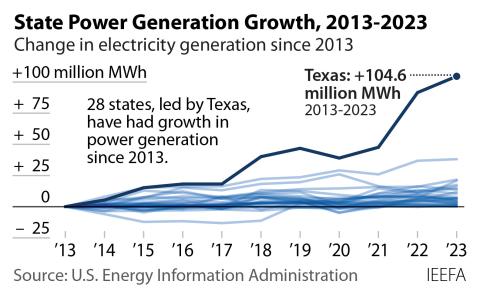A half-built, high-priced nuclear white elephant
Download Full Report
Key Findings
The now-stumbling renaissance of nuclear power in Europe and the U.S. has been a story of delays and cost overruns, with a new generation of untested nuclear power designs proving much harder to build than anyone imagined and even the project developers admitting to high levels of risk.
While lessons have been learned, the history of recent nuclear projects makes it very likely, perhaps probable, that Hinkley will cost substantially more and take far longer to build than its advocates are claiming.
Given EDF’s already delicate finances, large budget overruns at Hinkley would threaten its balance sheet, precipitating calls for a further French state bailout, or a renegotiation of the terms of its existing contract with the U.K. government.
Executive Summary
Hinkley Point C, the over-budget and delayed 3,200 megawatt (MW) nuclear power project in Somerset, may never enter commercial operation—and the U.K. government needs to either be planning now for that possibility or risk being left holding the bag for a half-built, multibillion-pound white elephant.
Britain has signed on to buy power from the facility at a generous £92.50 per megawatt-hour, and sees it as a major piece of its climate change mitigation and energy security plans. Further, EDF (Électricité de France), the French state-owned utility building the plant, swears that all is good, with outgoing CEO Vincent de Rivaz telling The Guardian in July that there was “absolutely, definitely, totally” no chance that ratepayers would be required to pay any more for future delays and/or cost overruns.
But the similarities between Hinkley, which is now finally under construction after years of delay, and other troubled European and U.S. projects, particularly the recently shelved V.C. Summer plant in South Carolina, cannot be ignored.
Perhaps the most important similarity is in the question of what the project ultimately will cost.
Hinkley already is frequently described as the world’s most expensive power plant, with EDF estimating that the project will require £19.6 billion to build by the time it enters commercial operation, currently set for 2025. But others see higher costs, and any delays (more on that below) would inevitably lead to an increase in total costs. For example, the U.K.’s National Audit Office (NAO), which advises on the use of public money, calculates that the public subsidy for the plant could top £30 billion, and says the government needs a Plan B just in case.
Rising costs were the leading factor in the decision by SCANA Corporation and Santee Cooper, the two South Carolina utilities building the Summer facility, to cancel that project. Costs there soared from an originally estimated $11.5 billion to upward of $25 billion by the time the utilities said they would abandon the two unit, 2,200 MW project.
Other parallels with struggling and failed projects in Europe and the United States, which argue strongly for the development of a Plan B as NAO and others have suggested, include:
They all use untested technologies.
The 2.2 gigawatt (GW) Summer project was based on the new Westinghouse AP1000 nuclear plant design. Hinkley’s 3.2 GW project will use Areva’s European Pressurised Reactor (EPR). Neither has been tested on a commercial scale. Delayed EPR construction projects are still unfinished at the 1.6 GW Olkiluoto 3 power plant in Finland and at the 1.6 GW Flamanville in France. After the Summer cancelation, the sole remaining developer of the AP1000 design in the U.S. is Southern Company, which is building a two unit, 2.2 GW expansion at its existing Vogtle power plant in Georgia. Further EPR and AP1000 construction projects are under way in China.
These projects have all seen construction delays, of five to nine years so far.
Areva’s EPR reactor at Olkiluoto 3 broke ground in 2005 and was scheduled for completion in 2009; after multiple missed deadlines it is now due online in 2019. The planned EPR reactor at Flamanville broke ground in 2007, for completion in 2012, and is now also scheduled to begin service in 2019, but that date may slip further. The two Vogtle AP1000 units broke ground in 2011 and were due for completion in 2016/17. They now won’t be finished until 2021-2023 at the earliest.
They have all seen massive cost overruns, ranging from 79% to 250% to date.
The expected cost of the Olkiluoto EPR has risen to €8.5 billion (2012 estimate) from the original €3.2 billion. The cost of the Flamanville EPR has soared to €10.5 billion (2015 estimate) from the original €3.3 billion, without accounting for the recent regulatory finding that the entire reactor cover must be replaced by 2024. And even though EDF has barely broken ground on the Hinkley plant, it already has raised its cost estimate, as of July, to £19.6 billion from £18 billion. The estimated construction and financing cost of the Vogtle project is now above $25 billion, from a $14 billion original estimate.
The delays and cost overruns have caused extreme financial distress to the technology vendors.
Finnish utility TVO and French state-owned Areva are mired in multibillion-euro litigation over responsibility for cost increases at Olkiluoto. Areva already has recorded a €3.9 billion impairment on Olkiluoto, forcing a €5 billion bailout by investors including the French state, and also forcing Areva’s merger with French utility EDF. Westinghouse was liable for some, but not all, of the Vogtle and Summer cost increases, causing it to file for bankruptcy in March. That in turn triggered Toshiba, its corporate parent, to warn of a 1.01 trillion yen loss this year. Toshiba is on the hook for 794 billion yen in Westinghouse guarantees.
Internal turmoil at the developers indicates misgivings among those closest to the projects.
At EDF, Finance Director Thomas Piquemal resigned last year over the decision to push ahead with Hinkley. Media reports said that he preferred a delay. Union members of the EDF board have warned that the Hinkley project threatens EDF’s financial stability. Meanwhile, in the United States, a recently published audit of the abandoned South Carolina project revealed a 17% turnover in management and engineering staff during the audit period, which the auditor, Bechtel, described as “high for a typical nuclear project.” Bechtel also described low morale among on-site workers.
Please view full report PDF for references and sources.












